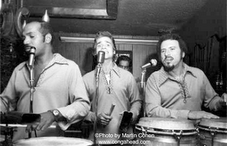
At the Park Plaza in 1939, Afro-Cuban jazz had a much different sound when Machito, under Mario Bauzá’s influence, played timid jazz solo partitas on and off as though uncomfortable in that Latin stronghold. They tried it out on the road, so to speak, before introducing it at the La Conga Club downtown. Machito never dropped his proud identity as “Machito y sus Afro-Cubanos.” Bauzá anglicized it. Tinkering with various descriptive names for his band, perhaps in desperation, Tito Puente announced before performing at the World Trade Center Marina, “I don’t play Latin jazz, I play Latin!” He soon discovered that it was here to stay.
As a confused votary purist, I miss the symmetrical “words and music” format of unadulterated Latin music. I don’t sense a proper commingling or easy synergism in Latin jazz. Like some canned output, it lacks soulfulness, which is very evident when heard separately in both jazz and Latin. As for the two Titos, a free spirit of artistic contention was evident in their rivalry. Like pugilists, they ended robust bouts in each others’ arms. Latinos and jazzistas don’t embrace enough. It’s fair to say that Latinos do not have a streak of arrogance in them. They acknowledge the genius, spontaneity, ritual, universality, and sophistication that is found in both camps. But is a happy wedding possible when family roots are involved? The roots of both are in Africa, but Afro-Cuban is Africa. White musicians are less likely to have been taught to play by their grandfathers or family members than Latins or black musicians. Music teachers are less of an influence than family ancestors who are listening from the Great Beyond. Are the self-taught less acceptable?
The musicians of either choosing donate love as a sacred obligation. Their hearts are drums that pulsate with echoes in chambers, murmurs in cavities, fluctuations in their veins. They keep the world resounding within Nature’s super bowl environment. They support a mystery that sings for humanity. They seem chosen.
As an orchestral organ when silenced or expressed, the forte music of Life comes to us as grief or as gaiety from the heart. That internal metronome and ultimate timer is also a sounding board where the vibratos, crescendos, and tremolos of daily life are played by impulse, much of which is for our ears alone.
Imagine an integration of DaVinci and Vasily Kandinsky, of Franz Liszt and Hindemith, or Calder and Rodin — interesting, but one does not mess with the heart or with its music, especially since all musicians are brothers.
As a confused votary purist, I miss the symmetrical “words and music” format of unadulterated Latin music. I don’t sense a proper commingling or easy synergism in Latin jazz. Like some canned output, it lacks soulfulness, which is very evident when heard separately in both jazz and Latin. As for the two Titos, a free spirit of artistic contention was evident in their rivalry. Like pugilists, they ended robust bouts in each others’ arms. Latinos and jazzistas don’t embrace enough. It’s fair to say that Latinos do not have a streak of arrogance in them. They acknowledge the genius, spontaneity, ritual, universality, and sophistication that is found in both camps. But is a happy wedding possible when family roots are involved? The roots of both are in Africa, but Afro-Cuban is Africa. White musicians are less likely to have been taught to play by their grandfathers or family members than Latins or black musicians. Music teachers are less of an influence than family ancestors who are listening from the Great Beyond. Are the self-taught less acceptable?
The musicians of either choosing donate love as a sacred obligation. Their hearts are drums that pulsate with echoes in chambers, murmurs in cavities, fluctuations in their veins. They keep the world resounding within Nature’s super bowl environment. They support a mystery that sings for humanity. They seem chosen.
As an orchestral organ when silenced or expressed, the forte music of Life comes to us as grief or as gaiety from the heart. That internal metronome and ultimate timer is also a sounding board where the vibratos, crescendos, and tremolos of daily life are played by impulse, much of which is for our ears alone.
Imagine an integration of DaVinci and Vasily Kandinsky, of Franz Liszt and Hindemith, or Calder and Rodin — interesting, but one does not mess with the heart or with its music, especially since all musicians are brothers.


No comments:
Post a Comment